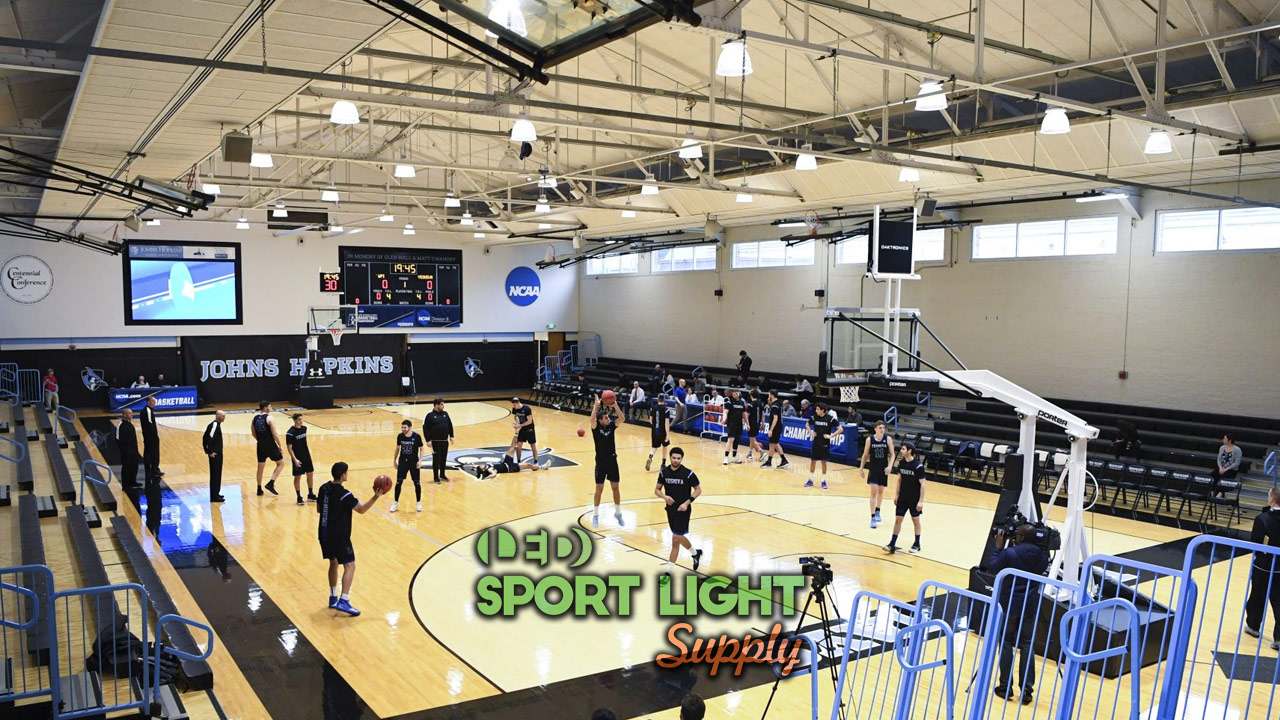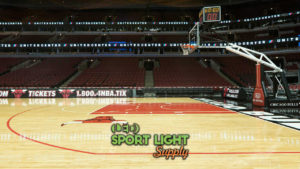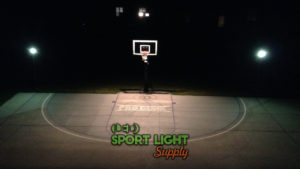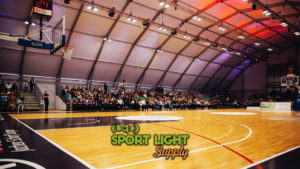These days, the layout and design of a basketball stadium lighting system start by outlining a flexible grid in a lighting app. A lighting designer considers the available space of the indoor or outdoor arena first. Then, the placement of the fixtures begins in accordance with the specific lighting requirement for your basketball court.
Small premise on basketball court lighting design complexity
At first, the designing process may seem a complex task. But in reality, it all comes down to a skillful procedure. One that involves basic concepts. You will read about these concepts in the following sections. As you will see, there is nothing hard about the fixtures and measurements. On the contrary, grasping the standard procedures will help you decide when to contact a lighting designer. And, of course, when you can fix a lighting issue yourself.
This guide opens with the main fixtures you will need to install. After that, you will learn about the rules of ideal sports lighting for playing basketball. Specific sections on the indoor and outdoor arena will follow to highlight the main differences. Lastly, a Q&A section will tackle some of the most frequent questions to give additional information.
What lights are used in the basketball court and stadium?
1. Flood lights for a basketball court
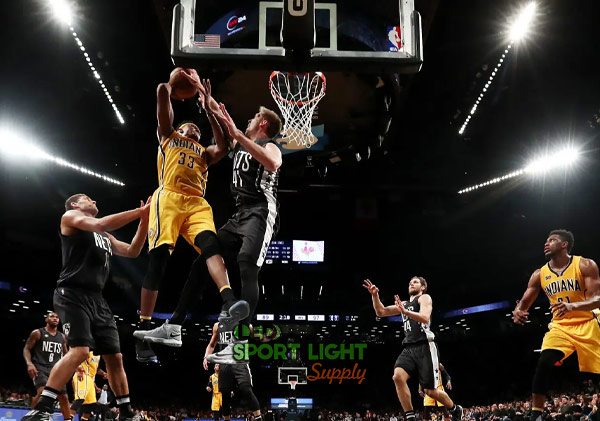 LED advancements made it possible to install a large variety of lamps in a basketball stadium. Flood lights are the first type. In brief, this fixture type has a broad beam angle (between 100 and 120 in most models).
LED advancements made it possible to install a large variety of lamps in a basketball stadium. Flood lights are the first type. In brief, this fixture type has a broad beam angle (between 100 and 120 in most models).
While flood lights are popular lighting devices to illuminate outdoor playing fields, they are pretty versatile. You can install flood lights anywhere you want. In this way, you can reduce the obtrusive light outdoor. Or improve the lighting uniformity level on the playing surface, as discussed later.
By design, flood lights are short-range devices. You have to tilt the fixture to a suitable degree to avoid glare or visual discomfort. But once you install enough flood lights correctly, the results are stunning.
Today, you mostly find them in outdoor basketball lighting systems. However, movable light towers still mount flood lights. This is why you can still use them indoors. Mainly as emergency or secondary lights.
2. High mast lights
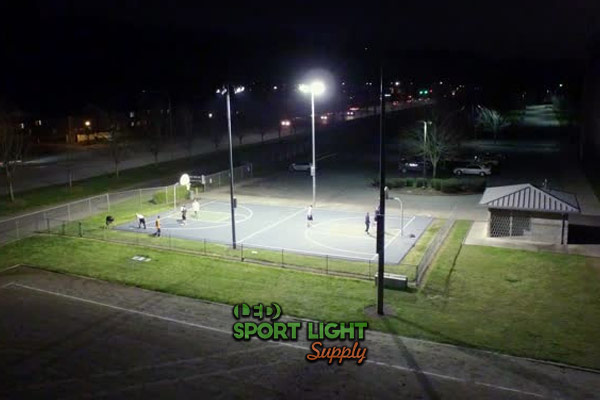 High mast lighting is the ideal solution for outdoor basketball courts. For one thing, light poles make an efficient and cost-effective lighting layout. But you still need to figure out which arrangement works best for your arena. You will read more about all the details later in the dedicated section about outdoor basketball court lighting.
High mast lighting is the ideal solution for outdoor basketball courts. For one thing, light poles make an efficient and cost-effective lighting layout. But you still need to figure out which arrangement works best for your arena. You will read more about all the details later in the dedicated section about outdoor basketball court lighting.
Once you installed all the high masts and fixtures, the lighting system provides adequate visibility. Such a bright light system prevents many injuries and referee’s mistakes. As you know, penalties for a foul can be a turnover or one or more free throws. So, lighting plays a critical role in high-intensity games. Plus, it makes fouls related to unsporting behavior quite obvious.
Traditional high mast lights and new LED light fixtures
Until three decades ago, you would have found only one of these traditional bulbs on a high mast:
- Halogen lights
- High-pressure sodium (HPS) lamps
- Mercury-vapor bulbs
- Metal halides
New generations of high mast lighting solutions integrate LED luminaries with adaptive wireless capabilities. In brief, you can replace your old high mast lighting and install a new light pole system that will lower your electricity bill. Thanks to remote control solutions like apps or Bluetooth connectivity, you can control the light from a distance. And do much more without having to move from one to another.
Usually, high masts last for two to fifty years. But the lights have a different life span. Depending on the type of lights, they will require more or fewer maintenance procedures. In any case, you can also use some light poles to mount solar lights for secondary or emergency lighting.
3. Solar lights
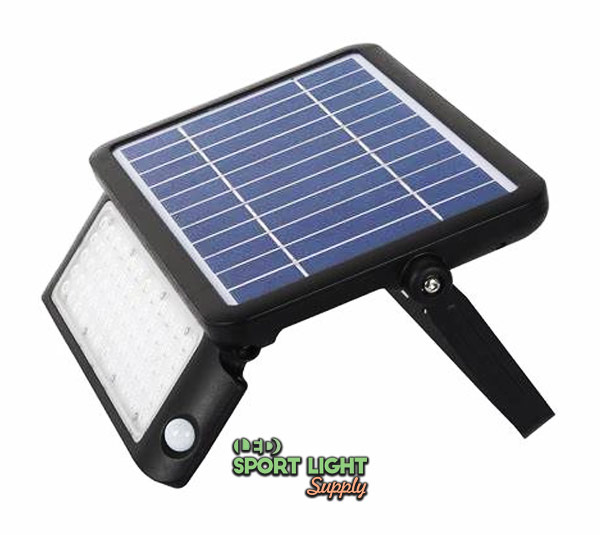 A solar light includes an LED fixture and a solar panel. Plus, a battery. Every solar panel contains smaller units called solar cells. Usually, the most common material used for making these solar cells is silicon, one of Earth’s most abundant semiconductors.
A solar light includes an LED fixture and a solar panel. Plus, a battery. Every solar panel contains smaller units called solar cells. Usually, the most common material used for making these solar cells is silicon, one of Earth’s most abundant semiconductors.
The main benefit of using solar lights is that they generate electricity. So, you save on your electricity bill. But some areas sunnier than others. Then again, less solar energy is available on cloudy days or at night.
On average, a solar fixture needs eight to ten hours of direct sunlight to recharge fully. Most basketball games start in the afternoon or the evening. So, these lights become a valid option for providing extra lighting.
Before you buy and install solar fixtures only
If you never bought one, you should know that current models are not bright enough for official games. Most commercial systems are currently 10-20% efficient. In other words, you will have to install plenty of them in an outdoor basketball court just to comply with a training lighting requirement.
In any case, these lights are a solid addition to any outdoor arena. They provide emergency and security lighting. And with each new generation of solar tech, solar cells become better and cheaper. As well as more competitive than electricity from the grid.
4. High bay lights
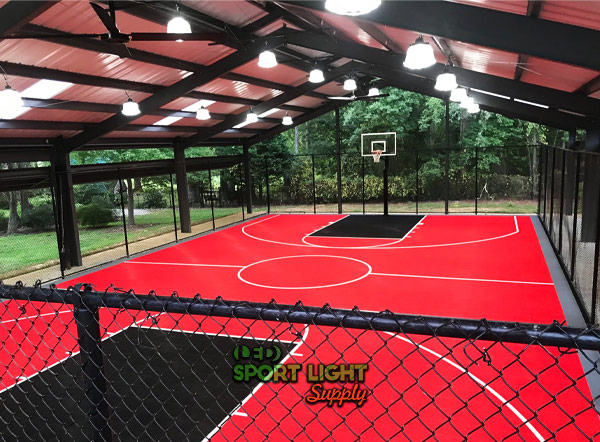 Lately, you find high bay lights in many sports facilities. These UFO-shaped fixtures have replaced the standard flood light in every indoor basketball stadium or arena. Mainly because they let you create the ideal lighting design.
Lately, you find high bay lights in many sports facilities. These UFO-shaped fixtures have replaced the standard flood light in every indoor basketball stadium or arena. Mainly because they let you create the ideal lighting design.
A high bay light hangs from the ceiling and provides light from above. From a technical perspective, the main concern regarding these lights is how to space them appropriately. In fact, even a lighting designer must consider the wattage, brightness, and overall dimensions to create an efficient layout.
In an old facility with all the wire connections for older models, equivalent LED replacements are available. Later models can also include a motion sensor, an emergency driver, and different mounting methods or hooks.
Most LED high bays lights for basketball are 150 or 200 watts. But more importantly, they do not cost much to run and provide optimal illuminance. They are the right lighting solution for an indoor basketball court.
5. Portable field lights or mobile light tower for outdoor basketball court
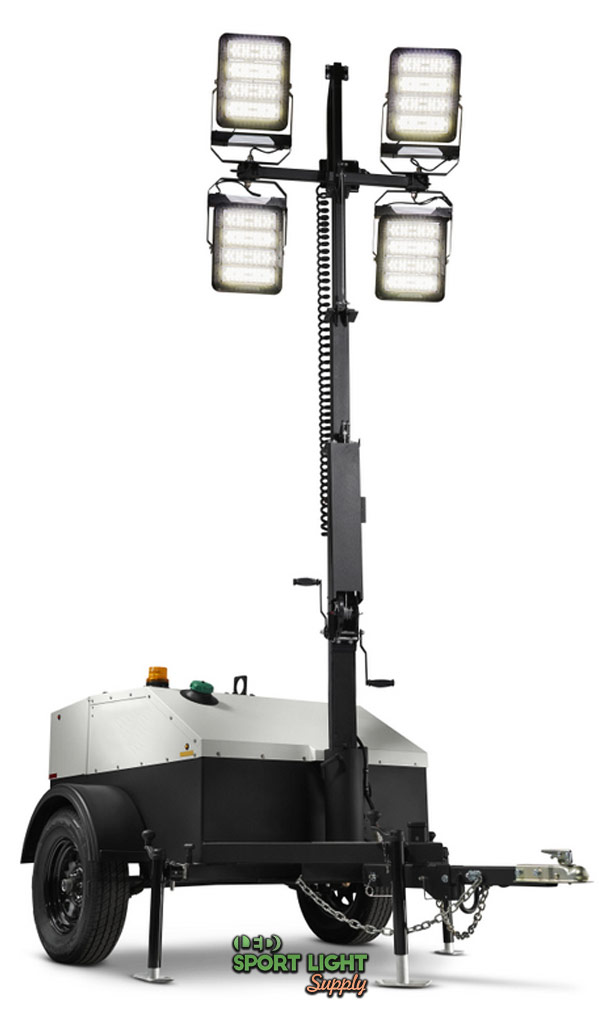 Sometimes we may want to temporarily illuminate the outdoor basketball court (or half court), so permanent high-mast lighting become less practical. In fact, we can use portable basketball court lighting. It is basically a mobile light tower system consisting of LED floodlights, a retractable light pole, a portable generator and a movable base. The lighting arrangement of the basketball court can be more flexible.
Sometimes we may want to temporarily illuminate the outdoor basketball court (or half court), so permanent high-mast lighting become less practical. In fact, we can use portable basketball court lighting. It is basically a mobile light tower system consisting of LED floodlights, a retractable light pole, a portable generator and a movable base. The lighting arrangement of the basketball court can be more flexible.
Portable light towers usually have 4 to 6 lights, and we can point them in different directions to achieve better lighting uniformity.
Basketball court lighting design
1. Lux and footcandle requirement
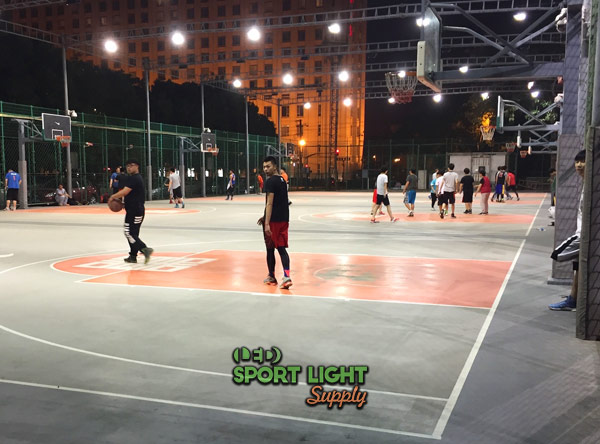 The lux requirement refers to how much brightness falls onto the basketball court. For American basketball stadiums, the equivalent standard is the footcandle, which uses the imperial unit system.
The lux requirement refers to how much brightness falls onto the basketball court. For American basketball stadiums, the equivalent standard is the footcandle, which uses the imperial unit system.
When buying any light, you will find a value that describes how bright that light source is. Namely, the lumen output. But the lumen value is not sufficient to find out how many lights you need to illuminate your basketball stadium. That is because we must meet a suitable light level over an entire area. That is, the lux requirement.
For every level of competition, different lux levels apply. As lux and footcandles describe the illuminance necessary to play safely, basketball associations require:
- 750 lux (69,7 footcandles) for top-class and international competitions
- 500 lux (46,5 footcandles) for national basketball games
- 200 lux (18,6 footcandles) for training and high school competitions
These light levels apply to indoor activities and events. For clarity, 1 footcandle equals 10,76 lux. So, you would need to divide any international lux value by 10,76 to get the equivalent footcandle requirement.
Outdoor basketball games and recreational activities
The lux standard for an outdoor basketball court demand lower values. Respectively, from the top-tier leagues to recreational use and training, you need only:
- 500 lux (46,5 footcandles) for the big international events
- 200 lux (18,6 footcandles) for any national competition
- 75 lux (7 footcandles) for rec use and training
FIBA uses a class system. In detail, the most demanding class is the first class, which includes international basketball events and televised games. Class II is the label that groups any regional and national basketball competition. Lastly, Class III includes recreational use and high-intensity training. Both Class II and III involve non-televised events only.
2. Lighting uniformity
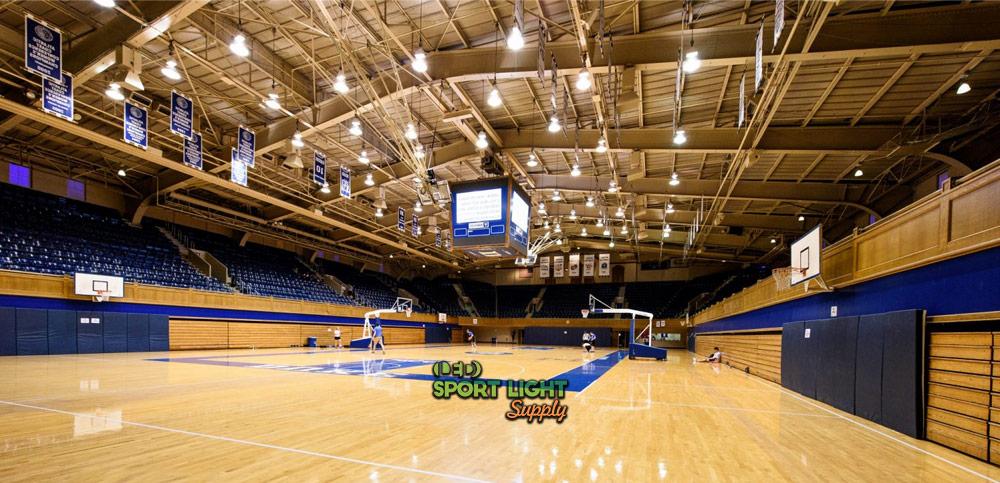
When playing basketball, a player may play tall. Then as soon as a center gets by a member of the opposite team, he or she may pass the ball to a point guard, who plays and get low.
Different playing styles and strategies may result in fast-pacing action. This is why all parts of the basketball court must be lit adequately. Otherwise, a difference in light quality may distract, blind, or deceive the players.
Think of rebounders or shot blockers. If the light sources do not evenly distribute the brightness on every part of the playing field, this could impact the strategy. For example, a team might avoid attacking from a particular zone. In short, the lighting uniformity requirement is critical for high-quality moves and matches.
In brief, this value expresses the variation in light intensity from a point on the basketball court to an adjacent one. You can calculate the uniformity by dividing the playing ground into a grid. Then, you take all the lux readings in every square by using a light meter. Alternatively, you can achieve the best lighting uniformity by designing the lighting arrangement thanks to the DIALux software. Or by contacting an expert lighting designer.
A lighting uniformity of 0.7 is necessary for every basketball game. But the requirement drops to 0.5 during training activities.
3. Color temperature
The concept of color temperature comes from the visible radiation that every solid body emits when heated. In detail, the color of this light depends on the temperature of the object. This dependency quantifies the white tone of all light sources.
As the name implies, the color temperature uses a scale in Kelvin (K) degrees to objectively describe a lamp’s white tone. For example, a LED light might emit a cool white light that resembles daylight. But a Metal Halide only produces a bluish-white light. Instead, a halogen or an HPS lamp cast light with a yellowish hue.
The flame of a candle that burns carbon particles emits light of around 2,000 K. As you know, a candle emits yellow light. The filament of an incandescent lamp reaches a temperature of 2,700-2,800 K. As a result, the latter emits a yellowish-white light.
For reference, sun rays at noon have a color temperature of around 5,000 K. The 5,000-5,5000 K range is the most sought-after color temperature for playing a basketball game indoors. But in multi-sports arenas, a white-tuning LED sports lighting system can offer more than one fixed color temperature to meet each sports requirement.
4. Glare (GR)
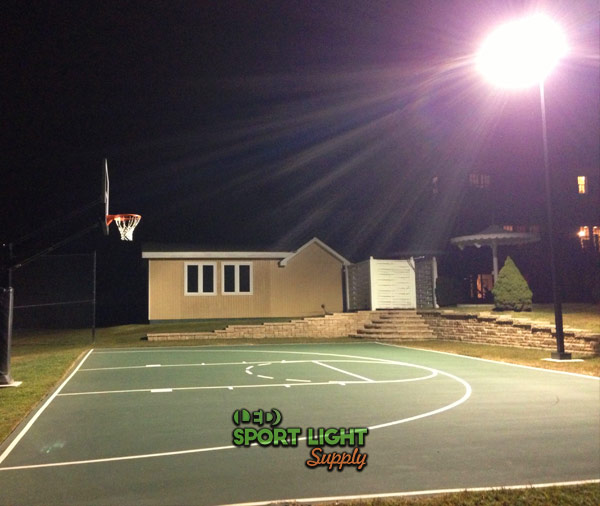 Human eyes can adapt to the glow of a powerful light source. But in that case, every detail in our field of view becomes hard to see. Once you put shields on the fixture, you restore visual comfort and can see everything with ease. The light intensity of the light source did not change. But the glare rating sure did.
Human eyes can adapt to the glow of a powerful light source. But in that case, every detail in our field of view becomes hard to see. Once you put shields on the fixture, you restore visual comfort and can see everything with ease. The light intensity of the light source did not change. But the glare rating sure did.
For playing basketball, the basketball stadium owner should maintain a GR of less than 50 at any given time.
Why is reducing glare crucial for playing basketball?
Basketball associations want you to comply with the glare rating system to reduce glare on the playing surface. Without glare, everything is visible. Injuries are less likely to occur. Even fouls or accidental contact with the opponent’s arms, hips, or knees decrease.
At the same time, visual comfort ensures correct refereeing. The referee can see and sanction an attack for charging if the player pushes past the defender already in position. Instead, poor lighting conditions can lead to more tension and frustration on the basketball court, resulting in unsporting behavior.
5. Color rendering index (CRI)
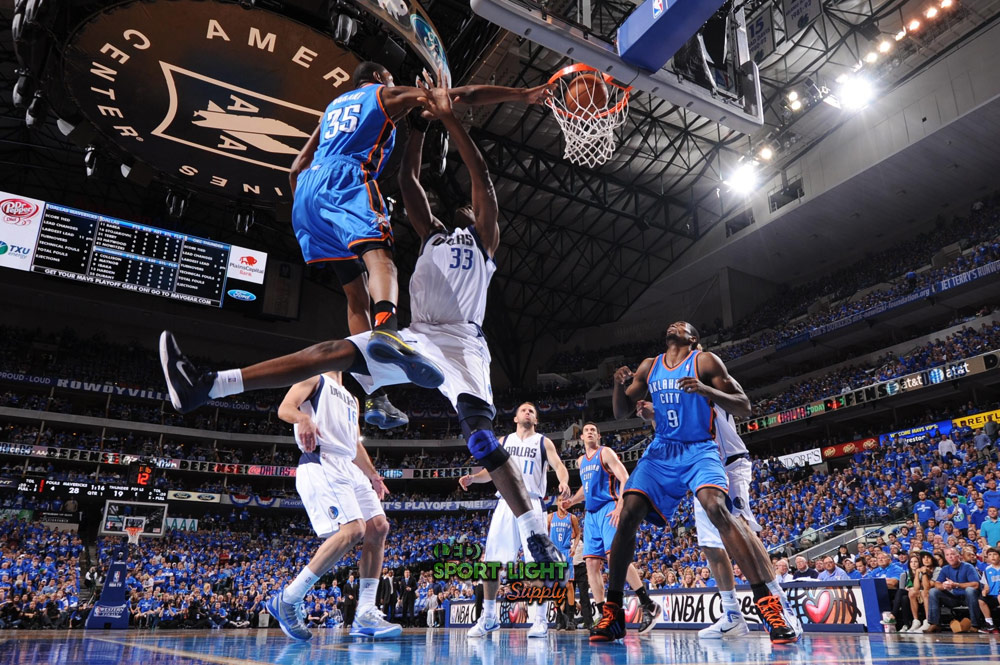
The CRI describes how accurately a specific light renders color video recording or photography. As you might guess, this is a vital requirement for TV broadcasters and sports magazines. A low color rendering can alter the skin tone of a player. Or the uniform colors.
A lamp with a high CRI value reproduces the correct color. In any case, you go outdoors and use the sun as a reference for near-perfect color reproduction. The sun produces a complete color spectrum. At a color temperature of 5,500 K, sunlight has a CRI higher than 98 Ra.
The Ra scale goes from 0 to 100. For televised indoor events during Class I and II basketball games, a CRI of at least 60 Ra is necessary. For class III activities, a CRI of 20 Ra is more than enough.
The CRI requirement might be hard to satisfy when using traditional light sources. For instance, a tungsten lamp lacks a blue color. A metal halide has the opposite problem. In fact, it produces mainly blue light. Similarly, a gas-discharge lamp usually lacks one or more tones. This is why opting for LED lights is recommendable.
Most LED lights have a CRI rating of more than 90 Ra.
6. Flicker-free light for broadcasting
Before an NBA event, thousands of fans gather in the basketball stadium. As the TV broadcasters stream the pre-game routine, the announcers provide passionate commentary. The fans at home are ready to binge drink and scream for a couple of hours. Everything is set for a successful and entertaining evening. Then, the whistle blows.
If you ever watched a big match on a TV, you should have noticed how much the streaming quality matters. Well, the lighting system is mainly responsible for picture quality. In the previous section, you found out about color rendering. But another requirement is imperative when it comes to televised events and big basketball leagues. This requirement is flicker-free lighting.
LED lights and flickering issues
LED advancements made this tech cheap and widely available. But all earlier generations of LED lights shared a characteristic that made video recording impossible. That is, a flicker that causes banding and a flickering effect during broadcasting.
Standard LED lights flicker by design. But some recent models offer flicker-free light. If you plan to host NBA, FIBA, ABA, or other major basketball leagues, make sure to install flicker-free lights only.
Outdoor basketball court lighting layout
1. Number of light poles
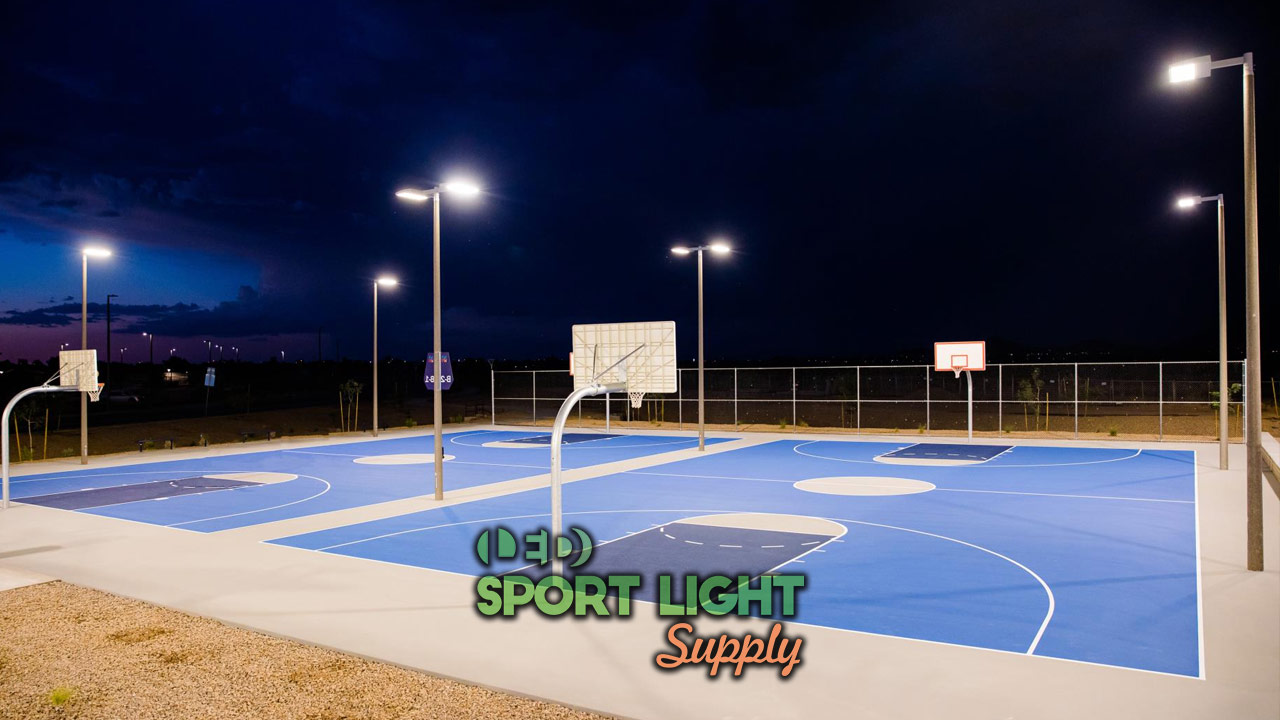
High mast lighting provides illuminance thanks to a skillful combination of the right layout and pole height. During the design process, the number of light poles influences the overall layout.
If you want to renovate an old sports facility and create a new outdoor court, you should consider changing the light poles as well. Most likely, one thinks to keep the old high mast system as it is to save on the budget. But depending on your project, a lighting layout with a different number of light poles may increase your ROI.
In a university sports facility, a four-pole layout for each court may be the ideal solution. Especially if they have to illuminate more than one court. For instance, imagine three basketball courts, one next to each other. With a four-pole layout, you would only need one pole on each side. But if every court shares at least one pole, you will save both on space and running expenses.
Other layouts might need up to six light poles. Usually, the bigger the outdoor court, the higher the number of high masts.
2. Light pole height
LED light quantity does not mean brightness. As you might know, each LED light has a different lumen output. Similarly, pole height does not always translate into a major benefit.
Usually, a short pole height would let you install less powerful lights. As a result, you end up lowering wattage and general expenses like replacements and maintenance. But a short pole layout may indeed cost you more money in the end.
Conversely, a tall light pole can illuminate a large area with just one set of luminaries. But if the high mast is too tall, then all sorts of safety hazards may pop up. For instance, you may fall from heights to replace a bulb. Depending on the material, the weight changes. Wind resistance is another factor. Wind-induced vibrations may bend or knock down the pole onto the basketball court.
On average, the recommended light pole height is anywhere between 29.5 feet (10 meters) and 39.4 feet (12 meters). Expert advice is strongly encouraged.
3. Position of light pole
As hinted at above, the number of light poles or outdoor courts may influence the position of the high mast lighting system. In a four-pole layout, the poles usually lie near the court corners.
The position of each light pole impacts the type of fixtures you need to install. By rights, if a lamppost illuminates two outdoor sports fields, then a luminaire ring is necessary. But if the high mast lighting system has to focus on just one basketball court, four sets of flood lights may be enough.
In a six-pole layout, illumination falls on the ground from the sides. Usually, four-pole illuminates the arcs and the paints from each side. The remaining two light up the central round and align with the central line.
For training and recreational use, a two-pole layout is sometimes used. But it should never be an option for playing any regular game.
4. Beam angle of LED basketball court lights
An outdoor high mast lighting system provides direct lighting. Therefore, the beam angle of the LED basketball court lights must achieve the illuminance levels without causing glare or visual discomfort.
Given that the beam cannot fall perpendicular to the playing surface, a large beam angle is necessary. The tilt of the fixtures is also a critical factor for reducing glare. In detail, the maximum tilt of LED flood lights is 70 degrees.
A large beam angle does not cause sky glow or light pollution per se. In fact, the tilt angle is what you need to focus on to reduce obtrusive light. So, you can get LED flood lights with a beam angle of 120 degrees.
Of course, the higher the mounting heights of the fixture, the lower beam angles you will need. For an accurate and efficient lighting design, please refer to experts. They will consider the boundaries of each adjacent zone. This is the best way to prevent light pollution in a densely populated area.
Indoor basketball court lighting layout
1. Direct lighting layout
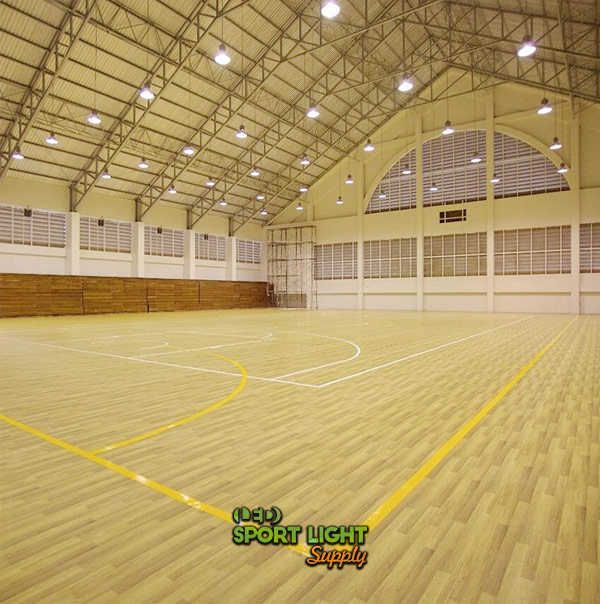 This lighting solution provides direct distribution of light. In brief, ninety to a hundred percent of the light falls on the indoor basketball court from maximum use.
This lighting solution provides direct distribution of light. In brief, ninety to a hundred percent of the light falls on the indoor basketball court from maximum use.
Depending on the type of fixture, you may achieve semi-direct distribution. In this case, sixty to ninety percent of the light reaches the playing surface. The remainder of the light shines upward behind the fixture itself.
High bay lighting is the most common type of light for direct lighting. As you can imagine, this solution provides optimal illuminance. But at the same time, it can create shadows. So, additional light sources may be necessary to compensate for increasing lighting uniformity.
Direct lighting is the obvious choice for most sports facilities. But if you want to create a more sophisticated ambient, then indirect lighting may be the right solution for you.
2. Indirect lighting layout
Indirect lighting refers to any light that bounces off of the ceiling or walls onto the basketball arena. For clarity, this lighting solution needs more powerful LED lights to compensate for the light loss factor.
Indirect light distribution directs ninety to a hundred percent of the light upward toward the ceiling. As a result, bounce lighting eliminates shadows. Mainly by illuminating the basketball court and players from 360-degree thanks to diffuse lighting.
The light spreads out from the light source. But it is not as concentrated. This means that it covers more surface area than direct lighting. On top of that, the final result is a more welcoming ambient with a prominent aesthetic appeal.
A mix of direct and indirect lighting is also possible. Especially for world-class basketball stadiums that host NBA and international basketball games.
3. Spacing between the high bay lights
The correct spacing of basketball sports lights ensures the best lighting results. Depending on the ceiling height, the layout will change and adapt. As a general rule, you can take the ceiling height and divide it by two. But for more accurate measurements and satisfying results, you need to hire a professional lighting designer.
In any case, every light should be at least three feet away from any wall. Otherwise, they will create shadows and make the ceiling feel a little short. This may not apply to high-intensity LED spot lights. But in this case, make sure you have room for optimal air exchange to avoid overheating.
The final layout will need to comply with the lux requirement. So, the spacing between the high bay lights must achieve a fixed lumen output. When the standard threshold is low, you can either increase the spacing or install a smart light control system. The latter solution is better suited for a basketball stadium that hosts local basketball activities, including basketball camps. Or other basketball programs for kids.
4. Number of high bay lights
Usually, a lighting designer uses DIALux software to estimate the number of basketball court lighting fixtures required to comply with the standard. With this software, the lighting design leaves no room to chance.
By calculating the right number to meet the lux requirement, you will find the most cost-efficient way to illuminate the basketball court. Such a lighting design provides adequate lighting that is neither too dim nor too intense.
Without professional software or expertise, you will have to calculate the total amount of lumens necessary to achieve the desired lux level. Above all, keep in mind that:
- the formula for calculating the total lumens is lux requirement x basketball court size (sq. meter) x 1.2 (light loss factor)
- once you found the total lumen output, divide the lumens by the lumen spec of the most efficient LED fixture you can afford
- you still need to install the lights in a way to achieve optimal lighting uniformity
Basketball court lighting Q&A
1. How much does it cost to light a backyard basketball court?
The average price of electricity varies by state and purpose. So, if you plan to build a backyard basketball court in your home, you will pay slightly more than a sports facility. On the other hand, one extra outdoor court for training with less than 200 lux will not impact greatly on your budget if you are a basketball stadium owner.
For a backyard basketball court with an illuminance requirement of less than 200 lux, you will need at least two 500W LED flood lights. More specifically, two models that provide at least 50,000 lm each. A residential installation will cost you around ¢11 per hour with an average price of 11 cents per Kilowatt-hour (kWh). But you may pay as low as ¢6 per hour for commercial purposes. When it comes to running expenses, location is a critical factor.
When it comes to the light fixtures, you can expect to pay anywhere from $100 to $200 for a 500W fixture with a lumen output of 50,000 lm.
2. What type of lamp or lamps are recommended to be used on a basketball court?
These days, LED flood lights and spot lights are the best options. In the past, the higher the voltage, the brighter the light. But with LEDs, wattage is lower than traditional light sources, and the lamps produce equally bright light. Often, LED lights emit more brightness than an equivalent MH or HPS because they are more cost-efficient.
Lamp efficacy is the most crucial factor for reducing running and maintenance costs. With this in mind, LEDs have the longest life span. An LED light lasts more than ten times more than a traditional light source. At the same time, LEDs do not suffer from design limitation as fixed color temperature or overheating.
High mast lighting with LED fixtures is the most popular and recommendable solution for an outdoor basketball arena. For lighting up an indoor court, LED high bay lights are the most cost-convenient.
3. How to design indoor basketball court lighting?
For starters, decide on the illumination standard of your basketball court. You will need to think about your goals and budget management. After that, seek professional advice for requesting a photometric analysis.
The more data you gather by yourself, the easier it will be to design the lighting layout yourself. But if you plan to host FIBA or national basketball league games in your stadium, hire a lighting designer.
Unlike outdoor sports fields, an indoor arena must comply with every requirement to meet the broadcasters’ and associations’ expectations. Since you cannot count on the sun, color rendering and uniformity will be your top priorities.

